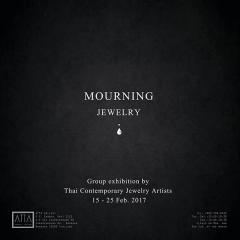นิทรรศการ “เครื่องประดับกับการไว้ทุกข์ : Mourning Jewelry”

นิทรรศการ “เครื่องประดับกับการไว้ทุกข์ : Mourning Jewelry” จัดแสดงระหว่างวันที่ 15 - 25 กุมภาพันธ์ 2560 ณ อัตตา แกลเลอรี่ : ATTA Gallery
ธรรมเนียมการไว้ทุกข์ในประเทศไทยนั้น มีมาตั้งแต่โบราณกาล ซึ่งเชื่อได้ว่าได้รับอิทธิพลมาจาก วัฒนธรรมจีน และ อินเดีย ที่ผู้ไว้ทุกข์มีการแสดงออกที่แตกต่างจากการใช้ชีวิตแบบธรรมดา เช่นการโกนหัว และการสวมใส่เสื้อผ้าสีขาวซึ่งเป็นสีที่แตกต่างไปจากสีเสื้อผ้าปกติที่สวมใส่ เพื่อแสดง ออกถึงความโศก เศร้าสะเทือนใจ ความอาลัยอาวรณ์ในผู้ตายให้ผู้อื่นได้รับรู้ ส่วนการสวมใส่ เสื้อผ้าสีดำนั้นคาดว่าได้รับ อิทธิพลจากวัฒนธรร ตะวันตก ในช่วงยุคสมัยรัชกาลที่ 4 (ค.ศ. 1851-1868)
ในปี ค.ศ.1861 นั้น ประวัติศาสตร์ได้บันทึกไว้ว่าหลังจากที่เจ้าชายอัลเบิร์ต (Prince Albert) พระสวามี ในพระนางเจ้าวิคตอเรียของอังกฤษสิ้นพระชนม์ลง พระนางเจ้าวิคตอเรียทรงเศร้าโศกเสียพระทัยเป็น อย่างมาก และได้ไว้ทุกข์จนเสด็จสวรรคต รวมเป็นเวลาถึง 40 ปี ซึ่งในตลอดระยะเวลานั้นพระองค์ ทรงเครื่องอาภรสีดำอันเป็นสีที่แสดงถึงความสูญเสีย และความโศกเศร้าเพื่อเป็นการไว้ทุกข์ รวมทั้งได้ มีการรับสั่งให้คนรอบข้างสวมใส่สีดำเพื่อเป็นการไว้ทุกข์ด้วย การแสดงออกของพระนางเจ้าวิคตอเรีย ปลุกกระแสการใส่เสื้อผ้าสีดำเพื่อเป็นการไว้ทุกข์ในอังกฤษ และเป็นจุดเริ่มต้นของการสวมใส่ Mourning Jewelry หรือแปลเป็นไทยได้ว่า “เครื่องประดับไว้ทุกข์” ที่นิยมทำจากวัสดุสีดำ เช่น Jet ซึ่งเป็นอัญมณีที่มีสีดำ, เส้นผมมนุษย์ อันเป็นสิ่งเสมือนความผูกพัน ในช่วงระหว่างการไว้ทุกข์อีกด้วย
อัตตา แกลเลอรี่ จึงมีความต้องการที่จะนำเสนอนิทรรศการที่มีแนวคิดเรื่องการไว้ทุกข์ผ่าน Mourning Jewelry ที่มีความร่วมสมัย รวมทั้งร่วมบันทึกประวัติศาสตร์หลังการเสด็จสวรรคตของพระบาทสมเด็จ พระปรมินทรมหาภูมิพลอดุลยเดช จากมุมมองของผู้ทำงานเครื่องประดับร่วมสมัยไทย จึงได้เรียนเชิญ ศิลปินเครื่องประดับไทยร่วมแสดงผลงาน “Mourning Jewelry...เครื่องประดับกับการไว้ทุกข์” โดยรายได้ 30% จากการจำหน่าย จะถูกนำไปบริจาคให้กับมูลนิธิชัยพัฒนา เพื่อถวายเป็นพระราชกุศล
รายนามศิลปิน
ฐิติรัตน์ คัชมาตย์, ทวีศักดิ์ มูลสวัสดิ์, เยี่ยมศิริ วรรธนะพินทุ, วินิจ กุศลมโนมัย, สรร ฉั่ว, จิตรกานต์ บรรเทิงไพบูลย์, ดร.สุภาวี ศิรินคราภรณ์, ทัศน์ฐรสชง ศรีกุลกรณ์, ธชย วชิราดิศัย, นุตร์ อารยะวานิชย์, นุ่น ภาสมา, ประยุทธ ศิริกุล, ปัญจพล กุลปภังกร, ผู้ช่วยศาสตราจารย์ ดร.วีรวัฒน์ สิริเวสมาศ, พรฤดี บุญยะพันธ์, ภิรดา เสนีวงศ์ ณ อยุธยา, ลุค ซาโตรุ, วดี ยืนยงพิสิฐ, วินิตา คงประดิษฐ์, ศริณญา ประเสริฐสรรค์, นภกมล ชะนะ, อตินุช ตันติวิท, เอกชัย พันธ์อารีวัฒนา..........................................
Mourning tradition has been present in Thailand throughout our history. It is believed that Thai mourning tradition was influenced by Chinese and Indian cultures, where the mourners exhibit behaviors that are different from their normal day to day behaviors such as shaving their heads and wearing white garment to signal to others that they are mourning the deaths of their loved ones. The introduction of wearing black for mourning came into Thailand during the reign of King Rama the 4th (1851-1868).
In the year 1861, Queen Victoria of England lost her beloved husband, Prince Albert. She mourned the lost of her great love for 40 years until her own death. During the mourning period, it was said that Queen Victoria demanded that others wear black outfit to show their sorrow and sadness as well. This was believed to be the start of tradition of wearing black for mourning in England. Mourning jewelry, typically made with jet or hair of the dead, was also widely worn by mourners during the mourning period.
ATTA Gallery wanted to present the concept behind traditional mourning jewelry and how contemporary jewelry can be used in today’s mourning tradition. Moreover, it is our way of honoring the late King Bhumibol Adulyadej, who passed away recently, and of mourning this great loss. Thai contemporary artists are invited to participate in this exhibition. Thirty percent of the proceeds form this exhibition will be donated to Chaipattana Foundation in honor of the late King.
Participating Artist
Tithi Kutchamuch, Taweesak Molsawat, Yiumsiri Vantanapin, Vinit Koosolmanomai, Sun G. Chua, Jittrakarn Bunterngpiboon, Dr. Supavee Sirinkraporn, Tataroschong Sreekullkorn, Tachaya Wachiradisa, Nutre Arayavanish, Noon Passama, Prayut Sirikul, Panjapol Kulpapangkorn, Veerawat Sirivesmas, Pornruedee Boonyapan, Pirada Senivongse na Ayodhya, Luke Satoru, Wadee Yuenyongpisit, Winita Kongpradit, Sarinya Prasertsan, Nappakamol Chana, Atinuj Tantivit, Ekachai Phanareewattana
